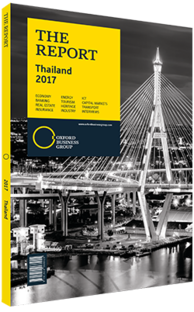Bank financing competes with bond markets in Thailand
Loan growth in Thailand fell in 2016 as slower-than-anticipated infrastructure spending and weak private consumption weighed on the consumer segment, while corporate lending fell as firms increasingly turned to bond markets for more favourable terms.
Outstanding bank loans in Thailand grew by just 2% in 2016 against 4.3% growth in 2015, according to the Bank of Thailand (BOT). The Thai Bankers’ Association (TBA) reports that this was the lowest lending growth recorded since a 1.7% contraction in 2009.
Although lending in the food, rubber, plastic, commerce and utilities sectors grew during the second half of the year, small and medium-sized enterprise (SME) lending fell to 1.8% in 2016, from 5.6% in 2015.
Corporate Vs Consumer
Corporate lending was also weak, reaching just 0.6% in 2016 from 3.1% in 2015, with the TBA reporting a slowdown in every sector except commerce and services. This comes as corporates are increasingly turning to bond markets in lieu of traditional bank financing, with Maybank Kim Eng reporting that corporate lending rose by 1.4% during the first nine months of 2016, compared to a 14% increase in corporate debt issuance in the same period.
Although consumer loans were the best-performing segment in 2016 at 4.9%, consumer lending also slowed from 7.1% in 2015. Loan growth ranging between 5% and 6% annually is considered healthy, according to a November 2016 report in Nikkei Asian Review.
NPLS: The lending slowdown is partly attributable to rising incidence of non-performing loans (NPLs). Fitch ratings agency reported in February 2017 that 11 listed banks, accounting for 85% of total loans, saw NPL ratios rise to 3.5% in 2016 against 3.2% in 2015. The BOT reports that NPLs accounted for 2.83% of lending in Q4 2016, up from 2.55% in 2015.
NPLs in consumer lending rose to hit 2.71% as of December 2016, compared to 2.56% a year earlier, while special mention loans – those overdue by more than 30 days but less than 90 – rose to 2.63% at the end of 2016 compared to 2.38% at the end of 2015. NPLs were most prevalent in the SME sector, with the BOT reporting that bad loans in the segment rose to 4.35% in 2016, up from 3.5% in 2015.
“We’re not as worried about large-scale corporations because delinquency trends have been reasonable, and their loan growth has not been as high, so the segment is not under as much pressure,” Parson Singha, senior director for financial institutions at Fitch, told OBG.
NPL Insulation
Fitch reports bank profits will remain pressured by asset quality issues and lower fee-based income growth, though profits have remained relatively stable, with returns on equity hitting 11.9% in 2016 and 12.6% in 2015. Banks also benefit from adequate capital buffers, with loan-loss coverage among banks rising to 136% in 2016, against 131% one year earlier.
Perhaps most importantly, the recent increase in NPLs is more reflective of credit cycles than actual corporate economic health: companies that had previously been in default following an economic slowdown in 2014 were refinanced in mid-2015, with repayments beginning in mid-2017, meaning that rising NPLs in 2017 will be from companies that had already been in distress, rather than new defaults.
Brighter Outlook
The outlook for loan growth in 2017 is more positive as a result, with Fitch reporting that loan growth was projected to bottom out in 2016, rising in 2017 on the back of increased government and corporate investment spending, as well as slightly improved GDP growth. In January 2017 Maybank Kim Eng projected that lending growth at Thai banks would hit 6% in 2017, driven by growth in consumer loans. The following month, the BOT told media it expects loan growth will surpass the increase of 2016 by 2%.
Commercial banks have echoed these sentiments, projecting strong loan growth for 2017. Siam Commercial Bank (SCB) and Kasikorn Bank (KB ank) both forecast loan growth will reach between 4% and 6% in 2017. Lending rose by 5.8% at SCB and 9% at KB ank in 2016.
You have reached the limit of premium articles you can view for free.
Choose from the options below to purchase print or digital editions of our Reports. You can also purchase a website subscription giving you unlimited access to all of our Reports online for 12 months.
If you have already purchased this Report or have a website subscription, please login to continue.

